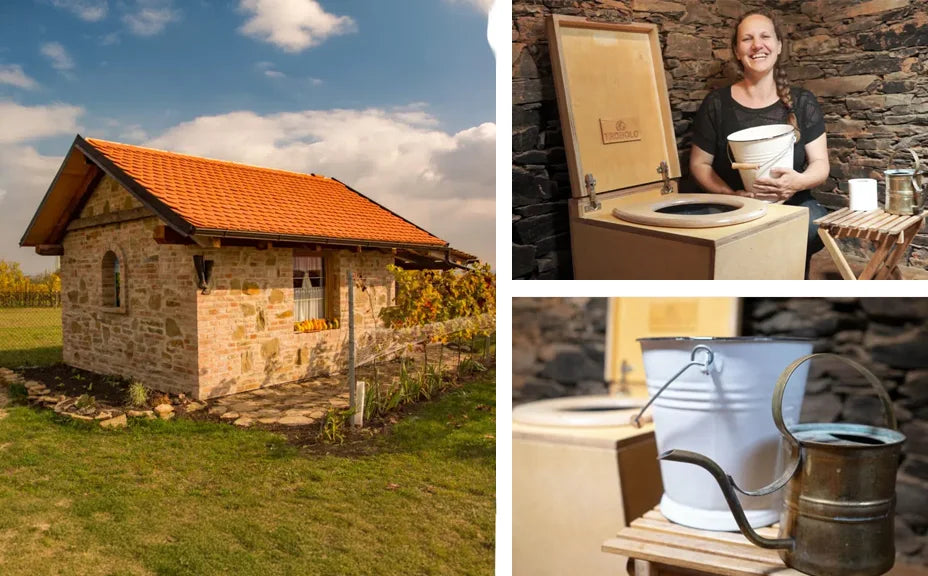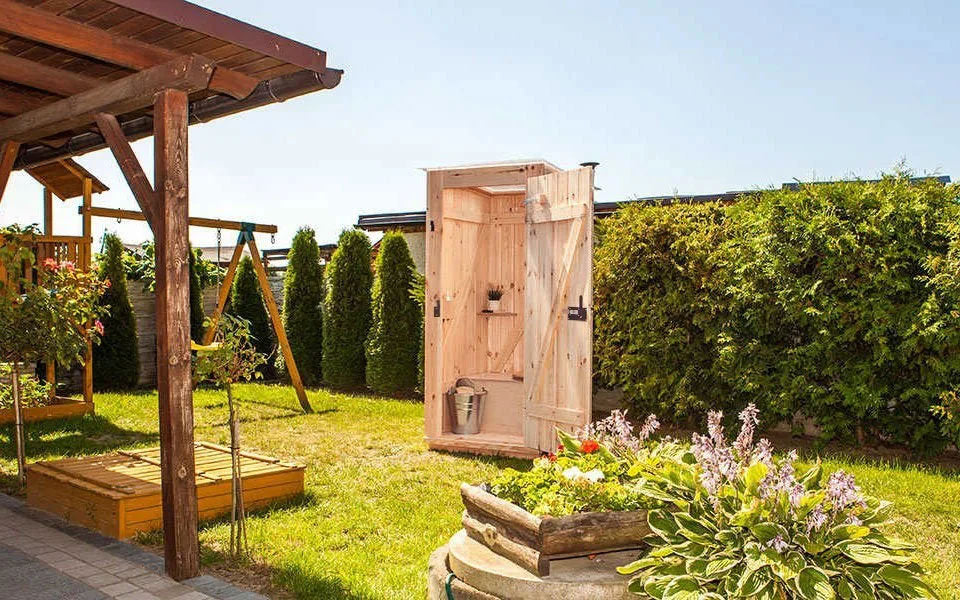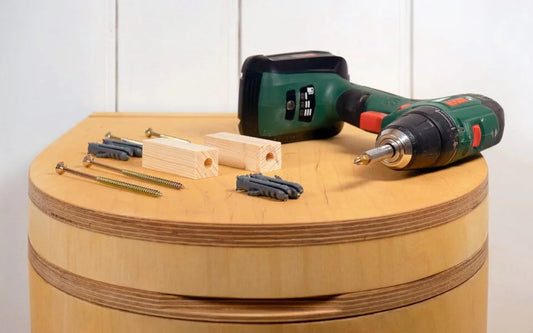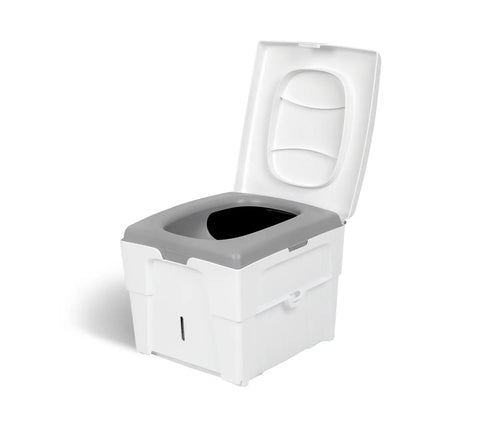

Our composting toilets for your garden
What is a garden toilet?
If you’ve been previously interested in the subject, you might have noticed that there is varied terminology around the semantic field of ‘toilet for the garden’. The terms ‘garden toilet’, ‘outdoor toilet’, ‘emergency toilet’ and ‘bio toilet’ have strictly speaking not been chosen very accurately and do not refer to any specific type of toilet.
Rather, when speaking of ‘garden and outdoor toilets’, a reference to possible areas of application outside of the domestic home is made, while the term ‘bio toilet’ suggests the environmental sustainability of the respective sanitary system.
Ultimately, all those types of toilet systems are broadly summarised under these terms as they are possible options for garden areas due to their functionality as sanitary facility.
For the sake of simplicity, we will use the term ‘garden toilet’ in the following and explain their functional requirements which cannot be directly deduced from the term ‘garden toilet’.
Garden toilet challenges
Garden lovers, allotment holders and even operators of all kinds of facilities that share outdoor areas as their common denominator, are familiar with the problems: sanitary facilities in garden areas are not a given, unfortunately, and providing these is often a difficult task. As a result, one often has to accept long journeys in order to relieve oneself. Those who eventually get weary of this situation and start looking around for a suitable garden toilet, will quickly encounter obstacles as the necessary connections for a regular toilet in garden areas are usually not available and as the installation of a water toilet is often even legally prohibited.
How, then, can sanitary facilities be provided in locations that do not provide any water or wastewater connections? What’s more, what type of waterless sanitary engineering meets the highest standards of comfort and hygiene without falling into stereotypical caveats against alternative toilet systems? These problems are reason enough for us to have a closer look at the issue of garden toilets.
Functional requirements for toilets in the garden
Before purchasing a specific garden toilet, you should think about the functional requirements that this unusual area of application calls for. The most important condition for the application and usage of a toilet in the garden is that the chosen toilet alternative functions without a water connection. The reason for this is the likelihood that the correct disposal of emerging wastewater via a sewage connection in one’s own garden as well as in arbours and allotments is impossible or that its realisation causes considerable costs. To avoid this, the only available options for garden areas are usually dry composting toilets – such as our TROBOLO – as well as composting toilets without a separation system or chemical toilets.
Provided that the condition of a waterless functionality is met, further functional requirements arise to guarantee a comfortable usage of a garden toilet. With this in mind, garden toilets that will bring you joy for years to come are particularly characterised by their easy operation. Furthermore, their appeal and user-friendliness is significantly increased if they can easily be emptied, cleaned and placed.

The solution for your garden house
If appropriate premises are already available, a variant without a toilet house can definitely be worthwhile. TROBOLO WandaGO, WandaGO Lite, TeraBlœm and TeraBlœm Plus can be used connection-free and offer comfort and hygiene at the highest level. These models are completely odour-free thanks to separation and bedding.
Due to the smaller size, these are sent to your home by parcel delivery. The TROBOLO WandaGO and WandaGO Lite are shipped fully assembled, so nothing stands in the way of immediate use. The TROBOLO TeraBlœm and TeraBlœm Plus come to you as a prefabricated kit that can be easily assembled within minutes and without tools.

Easy emptying of the garden toilet
In the case of dry composting toilets which separate excretions and thereby effectively prevent the development of unpleasant odours, one should be able to transport the collection container easily and more importantly, securely and in a liquid-tight manner as part of an uncomplicated emptying. Our TROBOLO containers for solids and liquids ensure exactly this thanks to a practical handle and an air- as well as liquid-tight closure. Transporting the containers is thereby secure, hygienic and uncomplicated.
Cleaning your TROBOLO
With our TROBOLO models, the solids container never comes into direct contact with the excreta thanks to the use of precisely fitting inlays.
The cleaning of your TROBOLO is therefore limited to the removal and subsequent disposal of the inlays and the occasional wiping of the surfaces with a damp cloth.
Comparison to other garden toilets
With other models, such as chemical toilets, emptying and cleaning requires special care due to the chemical substances used. This is because the chemicals used should under no circumstances come into contact with the skin.
Furthermore, the contents of a chemical toilet must never simply be added to the sewage system. Instead, the chemical mixture, which is sometimes hazardous to the environment, may only be emptied at designated disposal stations.
This means that the hygienic maintenance of a chemical toilet requires a lot more effort than a dry separation toilet.
If you are still interested in this type of toilet, we have compiled extensive information for you in our chemical toilet guide.

The right place for your garden toilet
Finally, the factor of easy position should be considered when choosing your garden toilet. Most notably, the aspect of whether you need an additional foundation to set up your garden toilet or whether a level surface is the only requirement plays a key part. The TROBOLO KersaBœm, our composting toilet for exterior areas, meets this requirement and, what’s more, does not need any tools for the set-up.
Making aids for the choice of the right garden toilet
As a result of legal bases which often prohibit wastewater in allotments and location-related conditions of other areas of application for garden toilets that do not have a water or wastewater connection, a plethora of consequences ensue that affect the choice of a suitable garden toilet.

A chemical toilet as a garden toilet?
Although chemical toilets function without a water connection and are thereby technically suitable for the usage in a garden, their chemical substances used do pose numerous risks for both humans and the environment, as mentioned before. The greatest caution should be exercised during the emptying and filling of the tank or collection container as the chemicals are toxic for all types of water and microorganisms and must therefore not come into contact with any garden areas or the water drainage at home – let along with your skin.
So if you’re fond of a functioning garden flora and fauna, you might want to refrain from using a chemical toilet when selecting your garden toilet.
Composting toilets in the garden
Classic composting toilets which collection excretions in one single collection container and – depending on the construction and capacity – only pre-compost or directly turn them into useful humus, function without any water connections and are therefore well-suited for a usage in the garden area. Furthermore, composting toilets reduce or even entirely prevent the development of odours thanks to the use of litter so far as an appropriate exhaust system has been installed.
The disposal of excretions is environmentally friendly and sustainable: the obtained humus can be utilised as fertiliser on ornamental plant beds at home and thus close the nutrient cycle. However, the more direct the composting of the toilet waste is to take place, the more complex and space-consuming the compost reactor’s performance usually becomes. Should the reactor be equipped with stirring units, heating rods or an exhaust system, electricity costs will also apply (however, these are usually only small).
More extensive information about the subject of composting toilets can be found in our guide of the same name.
Dry composting toilets as a garden loo?
The third toilet version which is perfectly suited for all of those locations without a water connection for a variety of reasons, is the dry composting toilet. Thanks to the separation of solid and liquid excretions, the development of odours is reduced to a minimum as unpleasant odours primarily result from the mixing of urine and faeces.
The addition of litter onto the solid excretions serves to visually cover them and to absorb the enclosed liquids which further minimises the development of unpleasant odours and additionally also significantly reduces the volume of the collected excretions. A dry composting toilet thus prevents odours before they can even develop and have a considerable advantage over the functionality of a composting toilet in this regard.
Moreover, the use of compostable inlays in the container for solids offers the option to dispose of the collected excretions along with the inlay into an external composter where they turn into useful compost soil together with garden and kitchen waste. This way, dry composting toilets also enable the return of valuable nutrients into the garden soil and thus close the natural nutrient cycle.
TROBOLO and composting
The more direct the composting of toilet waste, the more complex and space-consuming the design of the compost reactor usually is.
If it is equipped with agitators, heating rods or an electric exhaust system, there are also (albeit small) electricity costs.
We have compiled more comprehensive information on what and how to compost correctly for easy access.
When making your choice, urgently consider the legal basis for garden toilets
When deciding on a garden toilet, the aforementioned functional requirements can serve you as a guide and decision aid. Ultimately, however, the choice of a suitable toilet for garden areas always depends on individual requirements and careful considerations. Nonetheless, your decision may also be bound by different legal bases. This might particularly be the case if, like many other hobby gardeners, you are also looking for a toilet for your allotment.
Our conclusion on garden toilets from TROBOLO
All our TROBOLO models are based on the separation system just described and thus offer you a self-sufficient, because waterless sanitary technology, which is therefore ideal for use in the garden area.
Our TROBOLO KersaBœm and TROBOLO KitaBœm have been specifically developed for outdoor use with the highest standards of functionality, comfort and robustness. Thanks to their weather resistance, TROBOLO KersaBœm and TROBOLO KitaBœm can be used as garden toilets all year round – even in sub-zero temperatures – without any worries.
If you prefer to place your garden toilet indoors and are up for DIY, for example in your garden shed, you might like the TROBOLO TeraBlœm.
If your composting toilet will not have a fixed location, but will move from A to B or from indoors to outdoors as needed, we recommend our TROBOLO WandaGO. It has the same features as our wooden models, i.e. it is just as complete a composting toilet, and also scores with the advantages of conventional camping toilets: compactness, lightness, robustness. Thanks to its weather resistance, it is equally suitable for indoor and outdoor use all year round and can be transported with ease. Similar advantages are also offered by our TROBOLO BilaBox and the TROBOLO WandaGO Lite.
For more detailed information on how our TROBOLO composting toilets work, take a look at our info text “Function of the TROBOLO system“.
The right toilet for every occasion
Our best garden toilets for you
-

"Do-it-yourself" is the latest trend, so it's not surprising that more and more people want to build their composting toilet themselves. But how does that actually work?
Build your DIY composting toilet with ease
"Do-it-yourself" is the latest trend, so it's not surprising that more and more people want to build their composting toilet themselves. But how does that actually work?
-

In this TROBOLO guide on composting in the garden, we show you how to properly compost organic waste in your own garden. This allows you to support the natural cycle...
How and what to compost - The ultimate guide
In this TROBOLO guide on composting in the garden, we show you how to properly compost organic waste in your own garden. This allows you to support the natural cycle and at the same time obtain nutrient-rich humus.
-

Here you will learn everything about the emptying process of our TROBOLO composting toilets and the disposal of toilet waste.
How to empty a composting toilet
Here you will learn everything about the emptying process of our TROBOLO composting toilets and the disposal of toilet waste.











